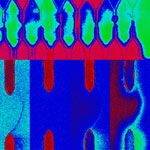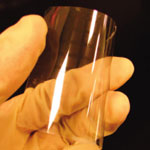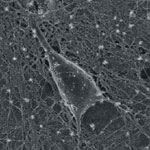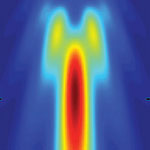Showing Spotlights 2081 - 2088 of 2783 in category All (newest first):
 One of the issues in using carbon nanotubes for applications is the challenge of separating metallic from semiconducting single-walled carbon nanotubes (SWCNT) after production. Developing a rapid and parallel technique for the electronic characterization of high-density arrays of SWCNT devices is essential for future large-scale production processes of nanoelectronics components. Currently used methods for electronic characterization of SWCNT devices and arrays are time consuming to set up, slow to execute, and not suitable for large-scale deployment. These methods include direct electron transport measurements and scanning probe microscopy, which can map the surface potential along a nanotube; again, a very slow technique with limited ability to be integrated into the process flow for microelectronic fabrication and characterization. More recent demonstrations of sorting nanotubes with DNA have been more promising but are very early stage. Researchers in Germany have now presented Voltage-Contrast Scanning Electron Microscopy (VC-SEM) as a new technique for the characterization of molecular electronic devices and device arrays.
One of the issues in using carbon nanotubes for applications is the challenge of separating metallic from semiconducting single-walled carbon nanotubes (SWCNT) after production. Developing a rapid and parallel technique for the electronic characterization of high-density arrays of SWCNT devices is essential for future large-scale production processes of nanoelectronics components. Currently used methods for electronic characterization of SWCNT devices and arrays are time consuming to set up, slow to execute, and not suitable for large-scale deployment. These methods include direct electron transport measurements and scanning probe microscopy, which can map the surface potential along a nanotube; again, a very slow technique with limited ability to be integrated into the process flow for microelectronic fabrication and characterization. More recent demonstrations of sorting nanotubes with DNA have been more promising but are very early stage. Researchers in Germany have now presented Voltage-Contrast Scanning Electron Microscopy (VC-SEM) as a new technique for the characterization of molecular electronic devices and device arrays.
Jan 7th, 2009
 The emerging field of transparent and flexible electronics not only holds the promise of a new class of device components that would be more environmentally benign than current electronics; being able to print transparent circuits on low-cost and flexible plastic substrates also opens up the possibility of a wide range of new applications, ranging from windshield displays and flexible solar cells to clear toys and artificial skins and even sensor implants. Three broad application areas for this technology are taking shape: transparent displays; flexible displays; and transparent/flexible electronics. Traditional materials used for transparent electronics include indium tin oxide films and indium oxide nanowires. In their search for materials that can offer even higher mobility and therefore even better performance, researchers have turned to single-walled carbon nanotubes .New work at the University of Southern California has now demonstrated the great potential of massively aligned single-walled carbon nanotubes for high-performance transparent electronics.
The emerging field of transparent and flexible electronics not only holds the promise of a new class of device components that would be more environmentally benign than current electronics; being able to print transparent circuits on low-cost and flexible plastic substrates also opens up the possibility of a wide range of new applications, ranging from windshield displays and flexible solar cells to clear toys and artificial skins and even sensor implants. Three broad application areas for this technology are taking shape: transparent displays; flexible displays; and transparent/flexible electronics. Traditional materials used for transparent electronics include indium tin oxide films and indium oxide nanowires. In their search for materials that can offer even higher mobility and therefore even better performance, researchers have turned to single-walled carbon nanotubes .New work at the University of Southern California has now demonstrated the great potential of massively aligned single-walled carbon nanotubes for high-performance transparent electronics.
Jan 6th, 2009
 The flurry of recent announcements regarding reports, international cooperations, and new research activities that deal with the potential risks of manufactured nanomaterials is a clear indication that the field of nanotoxicology is gaining momentum - and not too soon. While there still is no coherent international approach to determining if and what risks are posed by what kind of nanotechnology materials, individual research groups are picking certain areas of concern and forge ahead with - often highly specific - toxicology studies. A lack of standards and definitions makes these early investigations hard to compare and sometimes they even contradict each other, a situation that is especially confusing in risk assessments of carbon nanotubes. Some studies, though, present findings that, on the face of it, are especially worrying in their potential implications and deserve much more attention to be sorted out one way or another. A recent report on the toxicity of metal nanoparticles in soil is such an example.
The flurry of recent announcements regarding reports, international cooperations, and new research activities that deal with the potential risks of manufactured nanomaterials is a clear indication that the field of nanotoxicology is gaining momentum - and not too soon. While there still is no coherent international approach to determining if and what risks are posed by what kind of nanotechnology materials, individual research groups are picking certain areas of concern and forge ahead with - often highly specific - toxicology studies. A lack of standards and definitions makes these early investigations hard to compare and sometimes they even contradict each other, a situation that is especially confusing in risk assessments of carbon nanotubes. Some studies, though, present findings that, on the face of it, are especially worrying in their potential implications and deserve much more attention to be sorted out one way or another. A recent report on the toxicity of metal nanoparticles in soil is such an example.
Jan 5th, 2009
 Graphene is a recently discovered allotrope of carbon, which consists of a planar single sheet of carbon atoms arranged in honeycomb lattice. It has attracted tremendous attention of the nanotechnology research community owing to a number of unique physical properties. From a practical point of view, some of the most interesting characteristics of graphene are its extraordinarily high room temperature carrier mobility and recently measured extremely high thermal conductivity. The outstanding current and heat conduction properties of graphene are beneficial for the proposed electronic, interconnect, and thermal management applications. There is a realistic possibility that soon the fastest transistors and most sensitive detectors will be made out of graphene. For instance, we have just reported that next generation computer memory could be made of graphene. In order to build useful devices from materials which have only atomic thickness, one has to use extensively scanning electron microscopy, transmission electron microscopy, and focused ion beam processing. Unfortunately, all material characterization techniques which involve electron beam irradiation of the samples may result in damage to the material and disordering of the crystalline lattice. So far, despite the practical importance of the issue, the scale of this potential damage to single-layer of bi-layer graphene has not been investigated. What happens with the crystalline lattice has also been unclear.
Graphene is a recently discovered allotrope of carbon, which consists of a planar single sheet of carbon atoms arranged in honeycomb lattice. It has attracted tremendous attention of the nanotechnology research community owing to a number of unique physical properties. From a practical point of view, some of the most interesting characteristics of graphene are its extraordinarily high room temperature carrier mobility and recently measured extremely high thermal conductivity. The outstanding current and heat conduction properties of graphene are beneficial for the proposed electronic, interconnect, and thermal management applications. There is a realistic possibility that soon the fastest transistors and most sensitive detectors will be made out of graphene. For instance, we have just reported that next generation computer memory could be made of graphene. In order to build useful devices from materials which have only atomic thickness, one has to use extensively scanning electron microscopy, transmission electron microscopy, and focused ion beam processing. Unfortunately, all material characterization techniques which involve electron beam irradiation of the samples may result in damage to the material and disordering of the crystalline lattice. So far, despite the practical importance of the issue, the scale of this potential damage to single-layer of bi-layer graphene has not been investigated. What happens with the crystalline lattice has also been unclear.
Dec 30th, 2008
 Neural engineering is an emerging discipline that uses engineering techniques to investigate the function and manipulate the behavior of the central or peripheral nervous systems. Neural engineering is highly interdisciplinary and relies on expertise from computational neuroscience, experimental neuroscience, clinical neurology, electrical engineering and signal processing of living neural tissue, and encompasses elements from robotics, computer engineering, neural tissue engineering, materials science, and nanotechnology. In order for neural prostheses to augment or restore damaged or lost functions of the nervous system they need to be able to perform two main functions: stimulate the nervous system and record its activity. To do that, neural engineers have to gain a full understanding of the fundamental mechanisms and subtleties of cell-to-cell signaling via synaptic transmission, and then develop the technologies to replicate these mechanisms with artificial devices and interface them to the neural system at the cellular level. A group of European researchers has now shown that carbon nanotubes may become the ideal material for repairing damaged brain tissue.
Neural engineering is an emerging discipline that uses engineering techniques to investigate the function and manipulate the behavior of the central or peripheral nervous systems. Neural engineering is highly interdisciplinary and relies on expertise from computational neuroscience, experimental neuroscience, clinical neurology, electrical engineering and signal processing of living neural tissue, and encompasses elements from robotics, computer engineering, neural tissue engineering, materials science, and nanotechnology. In order for neural prostheses to augment or restore damaged or lost functions of the nervous system they need to be able to perform two main functions: stimulate the nervous system and record its activity. To do that, neural engineers have to gain a full understanding of the fundamental mechanisms and subtleties of cell-to-cell signaling via synaptic transmission, and then develop the technologies to replicate these mechanisms with artificial devices and interface them to the neural system at the cellular level. A group of European researchers has now shown that carbon nanotubes may become the ideal material for repairing damaged brain tissue.
Dec 29th, 2008
 The development of electron-beam lithography, focused ion beam milling, and other nanofabrication techniques has provided researchers with great freedom to pattern metallic structures at the nanoscale. This has fueled the design and implementation of new ultracompact photonic devices based on the plasmonic behavior of metals. Plasmonics is an emerging field of nanophotonics that relies on hybrid light-charge density waves on metal-dielectric interfaces and holds the promise for control of light at dimensions much below the free-space wavelength of light. Lenses have always been an important component for controlling light in optical systems. The focusing capability of conventional, dielectric-based microlenses however deteriorates as their physical dimensions are reduced toward a single-wavelength scale. That's why scientists have begun exploring alternative approaches to refractive lensing. While nano-patterning of optically thick metallic films was theoretically proposed as an alternative to refractive lensing, scientists at Stanford University have now reported the first experimental demonstration of far-field lensing using a plasmonic slit array.
The development of electron-beam lithography, focused ion beam milling, and other nanofabrication techniques has provided researchers with great freedom to pattern metallic structures at the nanoscale. This has fueled the design and implementation of new ultracompact photonic devices based on the plasmonic behavior of metals. Plasmonics is an emerging field of nanophotonics that relies on hybrid light-charge density waves on metal-dielectric interfaces and holds the promise for control of light at dimensions much below the free-space wavelength of light. Lenses have always been an important component for controlling light in optical systems. The focusing capability of conventional, dielectric-based microlenses however deteriorates as their physical dimensions are reduced toward a single-wavelength scale. That's why scientists have begun exploring alternative approaches to refractive lensing. While nano-patterning of optically thick metallic films was theoretically proposed as an alternative to refractive lensing, scientists at Stanford University have now reported the first experimental demonstration of far-field lensing using a plasmonic slit array.
Dec 19th, 2008
 Synthetic fibers are ubiquitous in modern society and their manufacture represents a huge, multi-billion dollar worldwide industry. Synthetic fibers - carbon fibers, nylon, polyester, kevlar, spandex, etc. - are manufactured from fossil fuels, usually from oil, but sometimes from coal or natural gas. Most of these materials are not biodegradable and, in addition to their significant carbon footprint during production, they pose environmental problems at the end of their life cycle. Natural fibers, on the other hand, such as wool and cotton, come from renewable animal or plant sources but they usually lack the high-performance characteristics of many synthetic fibers. This may change, as the new field of bio-based nanomaterials promises to deliver environmentally friendly, high-performance bio-fiber materials that can replace some of the synthetic materials.
Synthetic fibers are ubiquitous in modern society and their manufacture represents a huge, multi-billion dollar worldwide industry. Synthetic fibers - carbon fibers, nylon, polyester, kevlar, spandex, etc. - are manufactured from fossil fuels, usually from oil, but sometimes from coal or natural gas. Most of these materials are not biodegradable and, in addition to their significant carbon footprint during production, they pose environmental problems at the end of their life cycle. Natural fibers, on the other hand, such as wool and cotton, come from renewable animal or plant sources but they usually lack the high-performance characteristics of many synthetic fibers. This may change, as the new field of bio-based nanomaterials promises to deliver environmentally friendly, high-performance bio-fiber materials that can replace some of the synthetic materials.
Dec 18th, 2008
 Companies manufacturing, using, or selling nanoproducts in the Unites States would be well-served, at this early stage, to think proactively about minimizing future litigation risks. Candidly, the legal world has thus far lagged behind the growth in nano-related products and enterprises. But if the encyclopedic history of toxic tort, product liability, and environmental litigation in this country is any guide whatsoever, there is no reason enterprising plaintiffs' attorneys are less likely to tackle nanotechnology than other lucrative products and technological advances. Indeed, references to a potential link between carbon nanotubes and lung cancer have already sprouted on plaintiff-oriented websites across the country.
Companies manufacturing, using, or selling nanoproducts in the Unites States would be well-served, at this early stage, to think proactively about minimizing future litigation risks. Candidly, the legal world has thus far lagged behind the growth in nano-related products and enterprises. But if the encyclopedic history of toxic tort, product liability, and environmental litigation in this country is any guide whatsoever, there is no reason enterprising plaintiffs' attorneys are less likely to tackle nanotechnology than other lucrative products and technological advances. Indeed, references to a potential link between carbon nanotubes and lung cancer have already sprouted on plaintiff-oriented websites across the country.
Dec 17th, 2008
 One of the issues in using carbon nanotubes for applications is the challenge of separating metallic from semiconducting single-walled carbon nanotubes (SWCNT) after production. Developing a rapid and parallel technique for the electronic characterization of high-density arrays of SWCNT devices is essential for future large-scale production processes of nanoelectronics components. Currently used methods for electronic characterization of SWCNT devices and arrays are time consuming to set up, slow to execute, and not suitable for large-scale deployment. These methods include direct electron transport measurements and scanning probe microscopy, which can map the surface potential along a nanotube; again, a very slow technique with limited ability to be integrated into the process flow for microelectronic fabrication and characterization. More recent demonstrations of sorting nanotubes with DNA have been more promising but are very early stage. Researchers in Germany have now presented Voltage-Contrast Scanning Electron Microscopy (VC-SEM) as a new technique for the characterization of molecular electronic devices and device arrays.
One of the issues in using carbon nanotubes for applications is the challenge of separating metallic from semiconducting single-walled carbon nanotubes (SWCNT) after production. Developing a rapid and parallel technique for the electronic characterization of high-density arrays of SWCNT devices is essential for future large-scale production processes of nanoelectronics components. Currently used methods for electronic characterization of SWCNT devices and arrays are time consuming to set up, slow to execute, and not suitable for large-scale deployment. These methods include direct electron transport measurements and scanning probe microscopy, which can map the surface potential along a nanotube; again, a very slow technique with limited ability to be integrated into the process flow for microelectronic fabrication and characterization. More recent demonstrations of sorting nanotubes with DNA have been more promising but are very early stage. Researchers in Germany have now presented Voltage-Contrast Scanning Electron Microscopy (VC-SEM) as a new technique for the characterization of molecular electronic devices and device arrays.
 Subscribe to our Nanotechnology Spotlight feed
Subscribe to our Nanotechnology Spotlight feed





